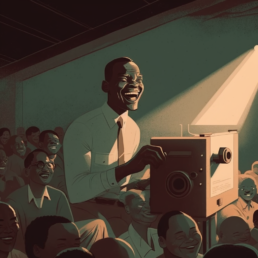In early 20th century Calcutta, an American musician and sound engineer, Fred Gaisberg, had a tough task- to find fresh voices to record for the new Gramophone Company. That hunt led to discovering the best female vocalists.
Just when Gaisberg was weary searching for the right voice, he was taken to a wealthy Bengali merchant’s house. It was there that a courtesan left Gaisberg mesmerized by her tone, voice, and range. Gauhar Jaan was unlike anyone Gaisberg had seen or heard before.
Gauhar Jaan was, however, no ordinary vocalist. She was an imposing figure, multilingual, and a trained singer in multiple classical forms such as Khayal, Thumri, Dhrupad, and Sadra. Attached to the court of Nawab Wajid Ali Shah, she was nothing less than a celebrity of her time.
When Gaisberg heard Guahar Jaan for the first time, he had already recorded some female artists like Soshi Mukhi and Fani Bala but he was not as impressed. Gauhar Jaan recorded some songs for Gaisberg in a makeshift studio in Calcutta.
When the records came out in 1903, they turned out to be a phenomenal success. Guahar Jaan would go on to be a leading voice for the Gramophone Company, recording more than 500 songs during her lifetime.
But how did Gaisberg land in Calcutta in the first place? The credit for that must be given to a German-American named Emile Berliner. Berliner may not be a standout name in the world of music, but his contribution to the modern form of recording was influential.
Berliner toyed with some upcoming audio technology in the 1870s. In 1887, he was given his first patent for a thing called the ‘Gramaphone’. It was a medium to record music on a cylindrical disc, a landmark invention that would send the world of music into a commercial tizzy.
Berliner’s Gramophone Company quickly moved to create an international portfolio, by establishing offices in Europe and Asia. In Calcutta, they set up an establishment in 1901, and by the end of that year, they were recording their first Indian music.
The gramophone records meant to be played at homes needed a different kind of appeal from the concerts. A soothing female voice was a more natural choice than that of a male. Hence, from a commercial perspective, female artists appealed more to the Gramophone Company.
So, the attention turned to female vocalists. But gnot just any vocalists, highly skilled performers, from a line of royal court dancers and musicians. Known and scarred in society as Baijis, they had a deep knowledge of music, passed down through generations.
Some of the notable female vocalists who came up during the same era as Gauhar Jaan and got contracts to sing exclusively for the Gramophone Company were Zohrabai Agrewali, Jankibai of Allahabad, and Sundrabai of Pune.
Fast forward to Bangalore, where in 1929 a veena player from the devadasi community, Madurai Shanmughavadivu took her 13-year-old Daughter to the office of HMV and persuaded them to record her songs.
When they heard her voice for the first time, they couldn’t believe their ears, the girl was a genius. From that day Subbulakshmi, or MS Subbulakshmi as she is better known, never looked back. Her records sold well and made HMV huge profits.
Shortly after that, HMV’s rivals, Columbia Records, found another child prodigy, a girl from Kanchipuram named Damal Krishnaswamy Pattammal. Markets were flooded with their records, and both Subbulakshmi and Pattammal became household names quickly.
For both Subbulakshmi and Pattammal to come up the way they did, one from the devadasi community and one from an orthodox Brahmin family, the gramophone was like a heaven-sent gift. Both went on to be colossal names in Carnatic and Indian Classical Music.
Marketing the gramophone was equally important. The Gramophone Company came out with some interesting advertisements creating a fusion of Western and Eastern cultures, from having Bengali babus, to gods and deities and Nipper the dog.
The gramophone didn’t just remain a recording medium when it landed in India though. It became an unbiased platform for talented musicians- especially female vocalists who even became commercially successful.
Sources: Amanda Weidman, Gender and the Politics of Voice: Colonial Modernity and Classical Music in South India, Cultural Anthropology, Vol. 18, No. 2 (May 2003), https://www.jstor.org/stable/3651521; Gerry Farrell, The Early Days of the Gramophone Industry in India: Historical, Social and Musical Perspectives, British Journal of Ethnomusicology , 1993, Vol. 2 (1993), https://www.jstor.org/stable/3060749




